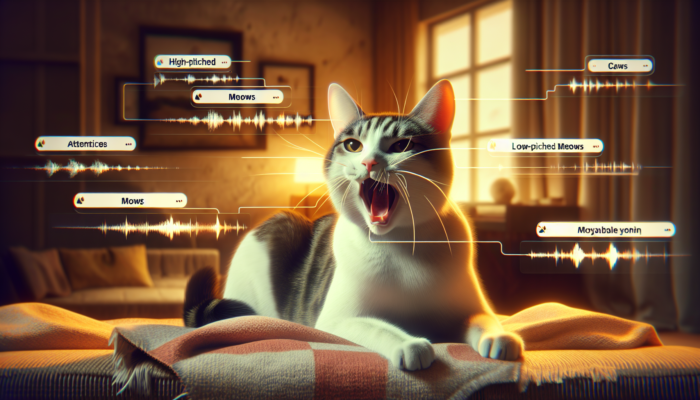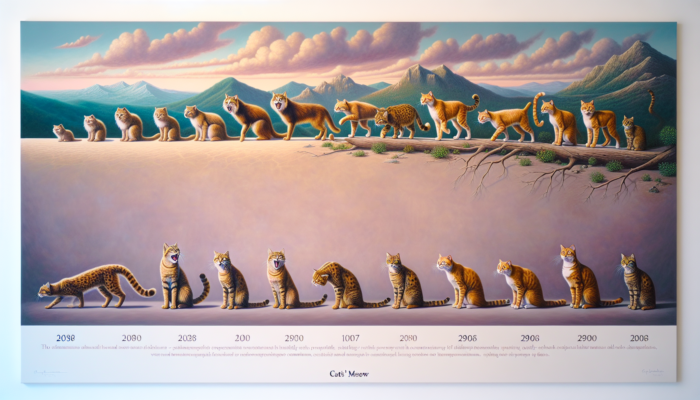Master the Art of Understanding Your Cat’s Meows: In-Depth Insights into Feline Communication
Delve into the meows of your cat: If you are lucky enough to have a cat as part of your family, grasping the nuances of feline communication is crucial for nurturing a fulfilling relationship. Each meow is not just a sound; it’s a complex expression of a range of emotions and needs, from hunger to affection. By honing your ability to interpret the subtle variations in a cat’s meowing, you can enhance the emotional bond you share with your furry companion, ultimately enriching the love and trust that defines your relationship.
Learn to Decode Your Cat’s Unique Sounds: Interpret Every Meow with Precision

Every distinct meow that your cat emits conveys a specific message, making it imperative for cat owners to invest time in learning how to accurately interpret these vocalizations. For instance, a prolonged, high-pitched meow might indicate your cat’s urgent request for attention or food, while a brief, low meow could be a sign of annoyance or displeasure. Furthermore, cats often alter their tone and rhythm in response to their emotional state and surrounding environment, creating a rich and intricate form of communication that reveals their inner feelings and desires.
Research shows that cats have an impressive ability to modify their meowing style to align with their human companions’ communication cues. This adaptability implies a level of awareness; a cat that actively observes its owner can learn to produce sounds that effectively capture their attention. By paying close attention to the subtle shifts in their meows, you can respond more appropriately to your feline friend’s needs, thus deepening your emotional connection and strengthening your bond.
Investigate the Motivations Behind Cat Meowing: Behavioral and Emotional Reasons
Cats engage in meowing for a multitude of reasons, with one of the most prevalent being a desire for attention. Domesticated cats quickly discover that this vocal expression effectively captures human focus. Additionally, meowing may also signal feelings such as anxiety or boredom. A cat that feels isolated or lacks stimulation may resort to meowing as a way to convey their need for interaction or entertainment, underscoring their reliance on human companionship.
It’s essential to recognize that certain breeds exhibit more vocal tendencies than others. For instance, Siamese cats are widely known for their frequent and expressive meowing, while some other breeds may display more subdued vocalizations. By understanding the specific circumstances in which your cat meows, you will be better equipped to respond to their emotional needs, ultimately enhancing the bond between you and your beloved pet.
Discover How Cats Utilize Meowing to Connect with Humans: Overcoming Communication Barriers
The meow serves as a unique communication tool that cats predominantly utilize to engage with humans. Unlike many other species, adult cats seldom meow at one another; this vocalization is primarily reserved for interactions with their human companions. This dynamic highlights the significance of this communication method in strengthening the bonds we share with our feline friends.
Cats frequently use their Meows to express fundamental needs such as hunger, thirst, or the desire to venture outdoors. They may also meow to convey emotions like joy or excitement, especially in the presence of their owners. By learning to respond to these meows, you not only cater to your cat’s basic requirements but also deepen the emotional connection you share, leading to a more fulfilling relationship.
The Intriguing History and Evolution of the Cat Meow

The meow boasts a fascinating history that traces its roots back to the evolutionary path of felines. Gaining a deeper understanding of the origins of this sound can provide valuable insights into how cats have developed their communication methods with humans over the years.
Trace the Ancestral Origins of the Meow: From Wild Cats to Beloved Domestic Companions
The forebears of domestic cats, such as the African wildcat, did not meow in the same way that modern domestic cats do. These wild felines primarily communicated through body language and a variety of vocalizations. However, as cats became domesticated, they evolved meows specifically tailored to engage with humans, adapting their communication methods to better fit their new surroundings.
This evolutionary transformation has been influenced by thousands of years of cohabitation with humans, who have unwittingly encouraged these vocalizations through their reactions and interactions. Over time, the meow has evolved into a versatile communication tool, enabling cats to articulate their needs and desires more effectively.
Uncover the Evolution of Cat Meowing: Understanding Domestic Influences on Feline Vocalization
The process of domestication has significantly impacted the evolution of the meow. While wild cats typically utilize more guttural and less varied sounds, domestic cats have developed an extensive range of meows that enhance their ability to convey messages to their human companions. This adaptability has allowed them to flourish in human households, underscoring their evolution as cherished pets.
Research suggests that cats adjust their meowing styles based on human responses, making their sounds more engaging and appealing. This evolution has enabled cats to blend seamlessly into family life, further solidifying their status as beloved companions.
Stay Informed on Recent Advances in Feline Communication Research: Insights About Cat Meowing

A growing body of research is dedicated to enhancing our understanding of the meow and its crucial role in feline communication. These studies have revealed remarkable insights, including cats’ ability to adjust their meowing based on their audience. For example, a cat might adopt a softer, higher-pitched tone when addressing a child, while utilizing a more assertive tone with an adult.
These discoveries pave the way for a deeper understanding of the emotional and behavioral needs of cats. By integrating this knowledge into your interactions with your feline companions, you can create a more enriching and responsive environment that caters to their needs.
Practical Strategies for Effectively Responding to Your Cat’s Meows
Knowing how to appropriately respond to your cat’s meows not only fortifies your bond but also contributes to their overall well-being. Here are several strategies that can assist you in comprehending and addressing your feline’s unique needs more effectively.
Boost Your Understanding of Cat Meows: Tips for Interpreting Feline Vocalizations
To accurately interpret your cat’s meow, it is crucial to be observant and attuned to their vocalizations. Take note of the tone and frequency of their meows. A rapid and repetitive meow may signify excitement or boredom, while a slower, deeper sound might indicate a request for comfort or affection, revealing the emotional context behind their vocalizations.
Furthermore, observing your cat’s body language in conjunction with their meows provides valuable context. For instance, if a cat meows while rubbing against your legs, they may be seeking your attention or affection. By incorporating these observations into your responses, you will be better equipped to meet your cat’s needs and emotions effectively.
Addressing Your Cat’s Needs Through Meowing: How to Respond to Feline Requests
Once you grasp the context behind your cat’s meows, it is essential to respond appropriately. If your cat meows to go outside, ensure you allow them to explore safely. Similarly, if your cat requests food, be diligent about adhering to their feeding schedule to promote a sense of security and stability.
Responding positively to your cat’s meows not only reinforces your emotional bond but also encourages your cat to continue communicating with you, enhancing mutual understanding and companionship in your shared life.
Strengthen Your Relationship with Your Cat Through Effective Meowing: Building a Deeper Connection
Utilizing meows as a form of communication can significantly enrich your relationship with your cat. By fostering an environment where your cat feels comfortable to meow, you promote positive interactions. This may involve engaging in playtime, cuddle sessions, or even training exercises that encourage your cat to express themselves freely without hesitation or fear.
By responding appropriately to your cat’s meows, you demonstrate your attentiveness to their needs, reinforcing trust and affection between you both. In turn, the meow evolves from a mere sound into a vital component of a fulfilling and loving relationship.
Investigate the Cultural Impact of the Cat Meow
The sound of a cat’s meow has made a notable impression on popular culture, influencing various forms of media, including music, film, and social platforms. Let’s examine how this iconic sound is represented across different mediums.
Exploring Meowing in Film and Television: Adding Depth to Characterization
In movies and television shows, the meow serves to enrich the personalities of feline characters. Films like “The Aristocats” and television series such as “Garfield” utilize the meow to convey emotions and character traits effectively. These portrayals not only entertain audiences but also help shape the perception of cats as affectionate and playful companions.
The meow is frequently employed to craft comedic or dramatic moments within narratives. Writers skillfully use this sound to evoke curiosity or agitation from cats, allowing viewers to forge a deeper emotional connection with these feline characters.
Appreciating the Influence of Meowing in Music and the Arts: Celebrating Feline Sounds
The meow has inspired countless musicians and artists throughout history. Iconic songs such as “What’s New Pussycat” by Tom Jones incorporate the sound of the meow to evoke themes of love and affection. Additionally, artworks depicting cats often reference the meow, showcasing the unique place these creatures occupy within human culture and the arts.
These artistic expressions serve as tributes to cats, encapsulating the essence of their behavior and character, and establishing the meow as a universally recognized and cherished sound across cultures.
Delving into the Viral Sensation of Cat Meowing on Social Media: Celebrating Cat Content
Social media platforms have transformed the online landscape, with videos featuring cats meowing achieving immense popularity. Platforms like TikTok and Instagram are flooded with content showcasing the delightful sounds of cats, attracting millions of views and likes. These videos not only entertain viewers but also educate them about feline communication, cultivating a vibrant community of cat enthusiasts.
Through the meow, cat lovers can connect, share their experiences, and gain insights into the behaviors and needs of these captivating animals. This viral phenomenon has fostered a global community centered around a shared passion for cats and their unique modes of communication.
The Importance of Meowing in Your Cat’s Health and Well-Being
The meow can be a critical indicator of your cat’s overall health. Becoming adept at recognizing changes in your cat’s meows can assist you in spotting potential health issues early, allowing for prompt intervention and care.
Identifying Health Issues Through Changes in Meowing: Understanding Vocalizations as Indicators
A sudden change in your cat’s meow could signify distress or illness. For example, a higher-pitched or more frequent meow might indicate pain or anxiety, while an unusual silence could suggest underlying health concerns that require further investigation.
It is crucial to listen attentively to your cat’s vocalizations and monitor any alterations in their meowing patterns. If you notice an abnormal meow that persists or is accompanied by other concerning symptoms, consulting a veterinarian is advisable to assess your pet’s health and well-being.
The Role of Meowing in Mental Health: Supporting Your Cat’s Emotional Well-Being
The meow plays a vital role in maintaining your cat’s mental health. Cats that feel secure and loved often meow joyfully during interactions with their owners. In contrast, a cat that feels neglected or bored may resort to excessive meowing as a means of seeking attention or engagement from their human companions.
Creating a stimulating environment filled with playtime, interaction, and mental challenges can encourage positive meowing. This not only contributes to your cat’s mental health but also fosters a more harmonious relationship between you and your feline friend.
When to Seek Veterinary Advice for Meowing Concerns: Ensuring Your Cat’s Health
Do not overlook any changes in your cat’s vocalizations. If you observe an unusual meow, particularly if it is accompanied by other symptoms such as lethargy or loss of appetite, it is imperative to consult a veterinarian promptly to rule out any serious health issues.
A professional can evaluate your cat’s condition, conduct necessary examinations, and recommend appropriate treatment if needed. By closely monitoring your cat’s vocal behavior, you can take swift action to ensure their health and well-being.
Fostering Positive Meowing: Techniques to Encourage Healthy Vocalizations
Encouraging positive meows can significantly enhance your cat’s experiences and fortify your bond. Here are some effective techniques to inspire healthy and joyful vocalizations from your feline friend.
Engaging Activities to Inspire Positive Meows: Fun Interaction Ideas
Participating in interactive play is one of the most effective strategies to encourage a positive meow. Toys that mimic the movements of prey, such as feather wands or laser pointers, can prompt your cat to meow excitedly during play. These sessions provide both mental and physical stimulation, leading to joyful vocal expressions that reflect your cat’s happiness.
Additionally, establishing a regular playtime routine helps to create an environment where your cat feels free to express themselves. By integrating play into your daily life, you can nurture a happy meow that deepens the connection between you and your feline companion.
Training Your Cat to Meow on Command: Enhancing Communication Skills
Training can be an effective approach to teach your cat to meow on command. By using positive reinforcement techniques, such as treats and verbal praise, you can associate a specific word or gesture with the act of meowing. This process not only improves your communication skills but also encourages your cat to express themselves more freely and confidently.
Moreover, training your cat to meow on command can be a delightful bonding opportunity, creating cherished moments while enhancing their communication skills and enriching your relationship.
Creating a Cat-Friendly Environment to Promote Positive Meowing: Welcoming Spaces for Vocal Cats
To encourage positive meowing, it is essential to cultivate a welcoming and stimulating environment. Ensure your home offers a variety of play, scratching, and resting areas. Cats thrive on exploration and stimulation, and an enriched environment can inspire joyful vocalizations that reflect their well-being.
Additionally, dedicate time each day to interact with your cat. Whether through play, petting, or simply engaging in conversation, these moments of attention can encourage your cat to meow positively and feel cherished, further reinforcing your bond.
Examining the Influence of Meowing on Human Relationships
The meow serves as a fascinating element in human relationships, often functioning as an emotional connector. Let’s explore how cats’ meows can shape our interactions with each other and strengthen our social bonds.
The Meow as an Emotional Connector in Families: Fostering Bonds Through Feline Communication
Cats that meow frequently can act as mediators within families, facilitating interactions and connections among family members. Children, in particular, can form affectionate relationships with their cats by learning to interpret their meows and respond to their needs, creating a nurturing atmosphere.
These interactions can reinforce family ties, cultivating a space where everyone learns to care for one another. In this context, the meow transforms into a symbol of love, understanding, and shared responsibility within the family dynamic.
Exploring the Role of Meowing in Animal-Assisted Therapy: Therapeutic Benefits of Feline Communication
Meows can also play a significant role in animal-assisted therapies. Cats are often utilized in therapeutic settings to provide comfort and alleviate stress for individuals of all ages. Their ability to meow soothingly creates a calming environment that can be beneficial for patients.
Engaging with cats can help reduce anxiety, promote feelings of happiness, and foster emotional stability, illustrating that the meow has a profound potential to positively affect mental health and emotional well-being.
How Meowing Influences Social Interactions: Enhancing Human Connections through Feline Communication
The meow can significantly shape our social interactions as well. Individuals who share experiences related to their cats’ meows may establish emotional connections, fostering friendships and supportive networks. Conversations about meows and cat behavior can strengthen relationships among pet owners and cultivate a sense of community.
Moreover, these discussions can encourage dialogue surrounding responsible pet ownership, creating a more engaged and caring community dedicated to animal welfare and the well-being of our feline friends.
Anticipating the Future: The Evolution of the Cat Meow and Feline Communication
The future of meowing and feline communication looks bright, with numerous innovations and research initiatives on the horizon. Let’s explore the trends reshaping our understanding of this unique language and its evolution.
Innovative Technologies for Analyzing Cat Meows: Advancements in Feline Linguistics
Recent technological advancements have simplified the understanding of cats’ meows. Researchers are employing machine learning algorithms to analyze meowing patterns and differentiate between various tones and meanings. These innovations hold the potential to revolutionize our ability to interpret our feline friends’ needs and desires.
Additionally, new mobile applications are emerging that allow cat owners to record and analyze their cats’ meows, providing invaluable insights into their vocal behavior and enhancing the owner-pet relationship.
Anticipating Changes in Meowing: Potential Developments in Feline Communication
As our understanding of feline behavior advances, the ways in which cats meow may evolve as well. Cats might learn to meow in even more precise ways to communicate with their humans, enhancing their ability to convey messages effectively.
This evolution could also be influenced by shifts in our lifestyles. For instance, cats residing in busy urban environments may develop distinct meows tailored to capture their owners’ attention amidst the noise and distractions of city life.
Current Research on Cat Meowing: Ongoing Studies and Their Implications for Cat Owners
Numerous research projects are currently underway, focusing on various facets of the meow and its implications for feline well-being. These studies delve into the environmental, social, and behavioral factors that impact the vocal language of cats.
The findings from this ongoing research could provide significant benefits for cat owners, enabling them to interpret their pets’ meows with greater accuracy and improve their overall quality of life through enhanced understanding and communication.
Frequently Asked Questions About Cat Meowing: Answers to Your Most Pressing Inquiries
Why Does My Cat Meow at Night?
Cats may meow at night for various reasons, including boredom, anxiety, or a simple desire for attention. Ensuring that they have sufficient stimulation and activities throughout the day can help minimize nighttime vocalizations, leading to a more restful night for both you and your feline companion.
How Can I Determine If My Cat’s Meow Indicates Distress?
Excessive meowing combined with behaviors such as hiding or restlessness may signify distress or discomfort. It’s essential to monitor your cat’s behavioral changes closely and consult a veterinarian if necessary to address any underlying issues.
Do All Cats Exhibit the Same Style of Meowing?
No, each cat possesses its unique meowing style, influenced by breed, personality, and past experiences. Some cats may naturally be more vocal than others, reflecting their individual temperaments and communication preferences.
Is Meowing a Strategy for Cats to Gain Attention?
Yes, many cats meow to attract their owners’ attention. They quickly learn that this sound can help them achieve their desires, whether it be food, affection, or playtime, showcasing their intelligence and adaptability.
Can Changes in Meowing Signal Health Problems?
Indeed, a sudden change in a cat’s behavior or vocalization can indicate potential health issues. If you notice significant changes in your cat’s meows, it’s advisable to consult a veterinarian to ensure your pet’s health and well-being.
What Strategies Can Help Reduce Excessive Meowing?
To minimize excessive meowing, ensure your cat is mentally and physically stimulated. Engage in interactive play, provide a variety of toys, and spend quality time together to help reduce vocalization and promote a calm environment.
Do Cats Meow Differently as They Age?
Yes, younger cats may meow more frequently than older cats. Kittens tend to be more vocal, while older cats may become quieter as they age, reflecting changes in their communication style and needs.
Can Meowing Indicate Behavioral Problems in Cats?
Yes, excessive or inappropriate meows can signal underlying behavioral issues. Collaborating with an animal behaviorist may help effectively address these challenges and improve your cat’s well-being.
What Signs Indicate That My Cat Is Happy?
A happy cat may meow joyfully, rub against you, and display relaxed body language. These positive signs are excellent indicators of their overall well-being and contentment in their environment.
Is Meowing a Universal Language Among Cats?
While meows may share similar meanings among many cats, each cat has its unique communication style. Owners should strive to learn and interpret their pet’s distinct vocalizations to strengthen their bond and understanding.
Connect with us on Facebook for exclusive updates!
The Article : Meows Explained: Understanding the Language of Cats Appeared First On Unity Pets.
The Article Understanding Cat Language: Meows Explained Was Found On https://limitsofstrategy.com

